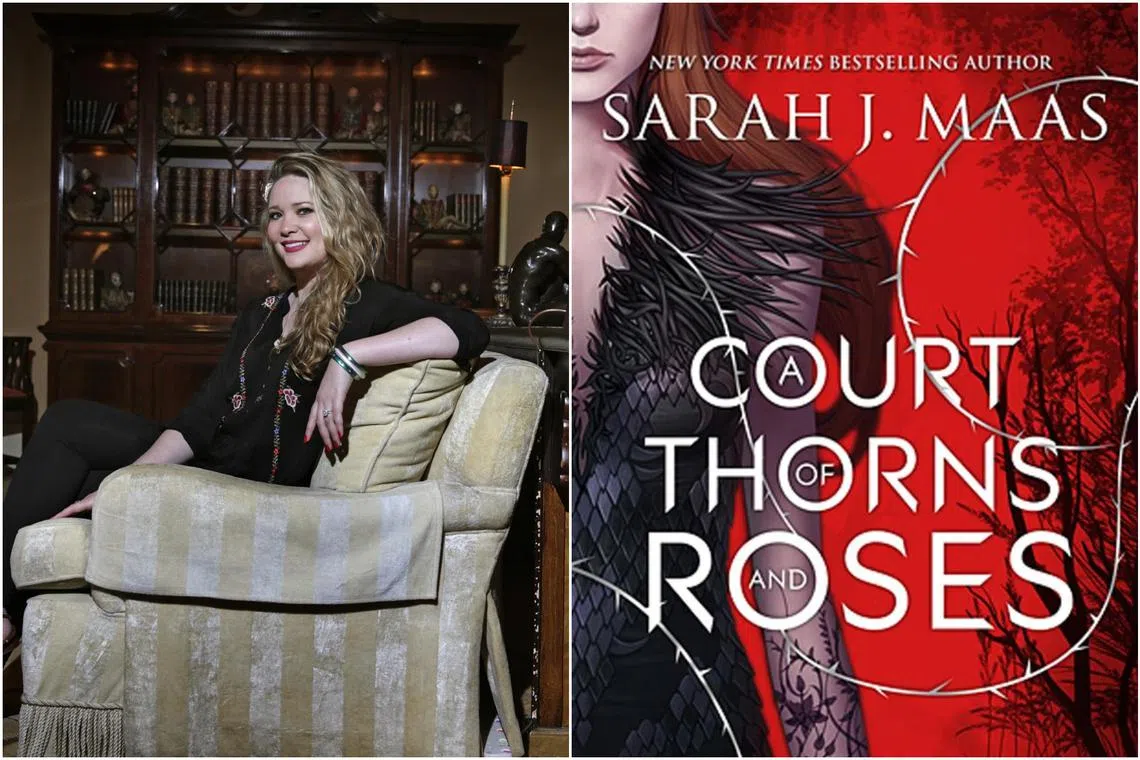The ‘romantasy’ novel is now an almost $820 million business sweeping publishing
Sign up now: Get ST's newsletters delivered to your inbox

Author Sarah J. Maas is a romantasy heavyweight, whose A Court Of Thorns And Roses series often serves as an entry point for readers who are new to the genre.
PHOTO: ST FILE, BLOOMSBURY
Follow topic:
NEW YORK – Dragons, faeries and happily-ever-after love stories are having a moment.
Sales of romantasy novels – a genre that blends fantasy’s epic quests and mystical characters with romance’s swooning gestures and spicy sex scenes – are projected to jump to US$610 million (S$817.8 million) this year, after hitting a record US$454 million in 2023, according to industry analyst Circana.
The number of books sold reached 11 million in the first five months of 2024, almost double the same period in 2023. And while Circana anticipates the books hitting a saturation point in 2025, their empowered female protagonists and cult followings make them likely to find permanent shelf space in stores.
The demand has been anchored by American author Sarah J. Maas, a romantasy heavyweight published by Bloomsbury Publishing, whose A Court Of Thorns And Roses series – known to fans as Acotar – often serves as an entry point for readers who are new to the genre.
The series follows a human huntress who is made to live in a faerie realm, only for her allegiances to be torn between two mythical kingdoms, and her heart between two faerie lords.
Fourth Wing, the first book in the newer Empyrean series by Entangled Publishing author Rebecca Yarros, about a scrappy cadet at an academy for dragon riders, is also fuelling growth, with another instalment coming in January.
But the Twilight boom of the 2000s – and the subsequent all-vampire-everything fatigue that followed – this is not.
Now, voracious readers of the genre can veer off into any number of subcategories. There are romantasy books about faeries and elves, humans and monsters, some set in far-off lands and others that infuse urban settings with magic.
Publishing houses are setting up dedicated imprints for such books, and entrepreneurial authors are cranking out new series for their very opinionated audiences. Recommendations, reactions and round-ups often go viral.
Romantasy’s success was a slow burn, then a head-over-heels free fall. Authors have blended and bent the two root genres for decades, says English professor Jayashree Kamble at LaGuardia Community College at the City University of New York.
Bloomsbury published the first Acotar book in May 2015. Word of mouth from fans and, later, the explosion of the corner of TikTok known as BookTok helped propel the series’ success. There are some 364,000 TikTok posts that sport the romantasy hashtag, and more than 1.4 million centred on Acotar alone.
Demand for Maas’ Bloomsbury titles – 16 books so far – drove revenue growth in the company’s consumer division for the fiscal year that ended in February, “cementing her position as a publishing phenomenon”, said the publisher.
It is not the first time a fantasy series has taken off for Bloomsbury. The company still cites its Harry Potter series, first published in 1997, as a major driver of revenue.
Romantasy readers range from teenagers, who hear about the books from their friends and social media feeds, to 30- and 40something women looking for a sweeping escape from their everyday lives. These are the people who grew up with fantasy books and movies but rarely felt represented.
The most popular books, such as The Lord Of The Rings and Game Of Thrones series, may feature a female character or two, but they support or are tangential to the male heroes. And while romance can play a part in such books, it is rarely the primary quest.
In romantasy, the hunt for true love is the story.
On the publishing front, companies are working to become more nimble, including by starting imprints, or smaller houses, dedicated to romance and romantasy. Entangled Publishing, already a romance-centric publisher, started Red Tower Books in 2022, with a global distribution by Macmillan Publishers.
Tor Publishing Group introduced Bramble, a romance imprint, in February 2023.
Editorial director Monique Patterson says Bramble hit profitability with its first list of titles, which included romantasy authors Jennifer L. Armentrout and Carissa Broadbent.
The imprint and other publishers are also tapping previously self-published authors with existing backlists and followings on social media, and a willingness to play into and often subvert existing formulas.
That includes keeping space open for romance novels that feature a hopefully-ever-after rather than a happily-ever-after, which has historically been considered the benchmark for what qualifies as a romance novel.
Patterson has not found that manuscript yet, but she is keeping an open mind. And like any healthy, budding relationship, she is excited to see where things go with the romantasy genre as a whole.
“If somebody asked me, ‘What do you think the timeline is for romantasy?’ I have no idea,” she says. “I think it can continue to evolve for as long as there are really wonderful new stories coming in.” BLOOMBERG

